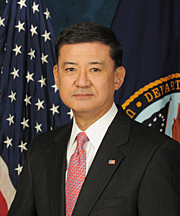
Department of Veterans Affairs Secretary and current USICH Chair Eric K. Shinseki.
|
The mission of the United States Interagency Council on Homelessness is to coordinate a federal response to homelessness and to constellate a National Partnership of every level of government and every element of the private sector to reduce and end homelessness, with a priority on chronic homelessness. The effective targeting of federal resources, and state, county, and city jurisdictional 10-Year Plans are key to this national approach.
I. More Federal Resources, Effective Targeting, and Collaboration
- April 20. VA announces the launch of its "Returning Veterans" web site and blog welcoming home veterans of the Iraq and Afghanistan conflicts. The new site, www.oefoif.va.gov, provides a wealth of information for veterans returning from Operation Enduring Freedom and Operation Iraqi Freedom and their families.
- March 2009. VA announces new opportunities to create housing for homeless and at risk veterans on VA campuses in
Georgia, Wyoming, Maine, Connecticut, and Illinois under Enhanced Use Lease program. RFP responses due May 29, 2009.
- March 11. President Obama signs the completed FY 09 federal budget that includes among other items $75 million for an additional 10,000 housing vouchers and supportive services under the HUD-VASH program for homeless veterans and $10 million for HUD to conduct a demonstration program in collaboration with the VA and the Department of Labor "to test the effectiveness of strategies to prevent veterans from becoming homeless. "
- On February 27, President Obama released a summary of his upcoming FY 2010 federal budget, entitled "A New Era of Responsibility: Renewing America's Promise." The summary indicates that the Administration will propose increasing funding for the Department of Veterans Affairs by $25 billion over the next five years including dramatic increases for VA health care. Special attention will be paid to enhancing outreach and services related to mental health care and cognitive injuries with a focus on improving access for veterans in rural areas. The budget will also propose expanding VA’s services to homeless veterans through a collaborative pilot program with non profit organizations. This pilot will help maintain stable housing for veterans who are at risk of falling into homelessness while helping the VA to continue providing them with supportive services.
- February 17. President Obama signed the American Recovery and Reinvestment Act that includes a Tax Incentive to Business to Hire Unemployed Veterans. Under current law, businesses are allowed to claim a work opportunity tax credit equal to 40 percent of the first $6,000 of wages paid to employees of one of nine targeted groups. The new law creates two new targeted groups of prospective employees: (1) unemployed veterans; and (2) disconnected youth. An individual would qualify as an unemployed veteran if they were discharged or released from active duty from the Armed Forces during the five-year period prior to hiring and received unemployment compensation for more than four weeks during the year before being hired.
- Women Veterans are focus of National Summit as VA Secretary expands health and treatment resources to more communities.
II. Representing the Interests of Homeless Veterans in State,
County and City 10-Year Plans to End Chronic Homelessness.
The United States Interagency Council on Homelessness believes that every state, county, or city jurisdictional 10-Year Plan to End Chronic Homelessness needs to give special attention and consideration to homeless veterans. Best practice in the convening of planning partnerships includes the early engagement of individuals and organizations that can effectively speak to the needs of homeless veterans and are knowledgeable about the resources and proven strategies to serve them. Results-driven 10-Year Plans will address directly the issue of homeless veterans including the development of jurisdictional data on their needs and the design of partnerships and investments that prevent and end their homelessness.
DID YOU KNOW?
VA is now accepting on-line applications for disability and other VA benefits through its VONAPP system. |
It is critical that states, counties and cities engaged in 10-Year Plan efforts be aware of and access resources available from the VA and from state and local departments and offices representing the interests of veterans to inform the development and implementation of their plans. These resources include, but are not limited to:
The United States Interagency Council on Homelessness will continue to encourage and support special consideration for the needs of homeless veterans in 10-Year Plans through the dissemination of information on helpful resources and innovations in planning and programs for veterans:
New and Innovative Solutions to Veterans Homelessness Emerging in western Massachusetts Through Initiatives and Partnerships of Soldier On
VA-New York City Initiative to End Veterans Homelessness “OPERATION HOME”
VA 30-City Initiative to Reduce the Incidence of Veterans Homelessness Through Expanded Substance Abuse Counseling
King County, WA Veterans and Human Services Levy
Washington State Department of Veterans Affairs Homeless Veterans Action Plan
10-YEAR PLANS WITH VETERANS STRATEGY EXAMPLES
FEDERAL AGENCY WEB SITES WITH HOMELESS SPECIFIC PAGES:
Community Homeless Assessment, Local Education and Networking Group (CHALENG) report on homeless veterans.
2009 Federal Benefits for Veterans and Dependents booklet.
State by State Incarcerated Veterans Re-Entry Guides
|







